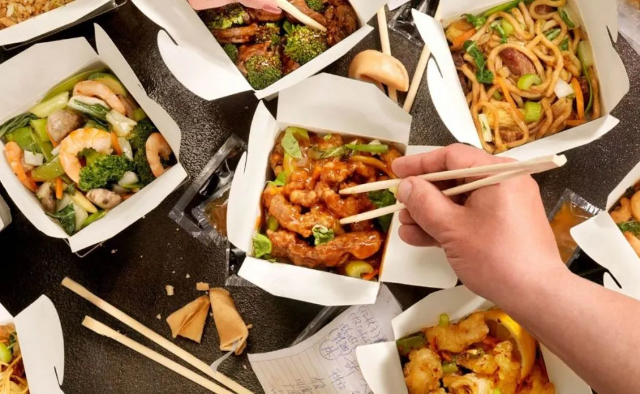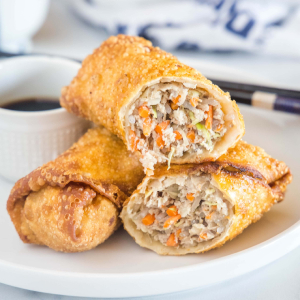It’s become fashionable to pooh-pooh the so-called ‘Cantonese’ section of Asian food menus. The snobs say it’s ‘not real Asian cuisine’. And as such, it should be shunned. Nonsense. American-Asian (Am-As) cuisine has its own venerable and colourful tradition!

Where it comes from
I’ve touched on this issue before, in reference to specific Asian-type dishes that really originated in North America. Chow Main and Chop Suey, for example. Notably, Broccoli with Beef, Ginger Beef, Almond Chicken and General Tso’s Chicken, to name just a few.
But just because these dishes are not found in Asia, doesn’t mean they’re in any way inferior. In fact, they were created by Asians who came to North America 150 years ago, and reflect their rich, collective heritage.
All thanks to the Railway
Tens of thousands of Chinese migrated to North America to build the US Transcontinental and Canadian Pacific Railways in the 1860s and 80s, respectively. Unhappy with North American foods, these intrepid newcomers sought out ingredients that could stand in for the ones they were used to ‘back home’.
That’s one reason Napa Cabbage, Bean Sprouts, European-style Broccoli (and Cauliflower), Carrots and Sweet Green Peppers are so popular in American-Asian dishes.
In the larger context, strtictly-Am-As sauces such as Sweet-and-Sour, Black Bean and Kung Pao define whole ranges of Am-As stir-fried dishes. On the other hand, the popular Oyster and Hoisin Sauces are almost-direct imports from Asia.
American-Asian food has a firm ‘seat’ in the San Francisco area, where many Chinese immigrants settled. But other major Pacific coast cities such as Portland, Seattle and Vancouver are also home to substantial Asian communities.
The Am-As menu
It differs from the traditional Asian profile not only in ingredients, but in prep styles. Although one of the main cooking methods – stir frying in a traditional Wok – characterises both. One clear difference is the tendency of Am-As cooks to blanche (par-cook) veggies in boiling water before frying.
In addition, battered and breaded dishes – such as the iconic S+S Chicken Ball – are Am-As classics not known in China. As are Egg Fu Yong and Egg rolls!
Soups such as Hot and Sour and Egg Drop are clearly and closely adapated from actual Chinese dishes.
Pork and Chicken (with shrimps and fish as a distant third) are the leading meats found in Am-As dishes. Beef is more common in American-Asian menus than it is in Asia. In ‘the old country’, cows are traditionally considered too valuable to slaughter just for their meat. And in some places, religious or cultural prohibitions exist that forbid consumption of beef.
Two kinds of Noodles
Pasta originated in Asia. And legend holds that it was brought back to Italy by adventurer Marco Polo. So it should come as no surprise that what we call traditional pasta – made with eggs and wheat flour – is a staple there, too.
Am-As noodle dishes are made with one of two distinct types of noodle.
One is the pulled noodle. It’s made by hand-pulling strands of dough ever-thinner. The technique is ages old and is usually passed down by masters to apprentices. Ask a noodle master, and he’ll tell you it’s ‘all in the wrist’! The dough gets its elasticity from the addition of alkaline water, which energises and strengthens the gluten in the flour.
Flat noodles are prepared by the classic rolled-and-cut method. They’re usually about 1/8 in. / 3-4 mm thick, and about as wide as a Fettuccine noodle.
One or another of these noodle styles appears, by Am-As tradition, in most noodle dishes.
And it’s interesting to note that rice noodles, as such, don’t figure prominently in Am-As cuisine.
Curry vs. Chili
The last, and perhaps most important distinction between Am-As and traditional Chinese cookery is the seeming divide over ‘hot’ spices.
Curries rule in Asia, and have for thousands of years. But for a hundred years in North America, curry spices could not be widely obtained. So, various southwestern Chilis were substituted for Asian ones in Indian and Southeast Asian masalas, and Chinese regional spice styles, notably Szechuan and Hunan.
Am-AS spicy dishes are rarely as hot as their Chinese counterparts. But some are made extra hot on purpose, to suit diners of Asian extraction or Western initiates to Asian cuisine who expect it. Am-As menus typically offer a choice of Mild, Medium or Strong spicing. That’s unheard of in classic Chinese cuisine. But Am-As resto operators know their customers, and give them what they want.
My take
While American-Asian food owes a great deal to traditional Chinese cuisine, it has developed a distinct and enticing character – and tradition – all its own. To you I say, “Don’t be afraid to explore it. And enjoy it guilt-free!” To the snobs, I say, “You don’t know what you’re missing!”
~ Maggie J.

